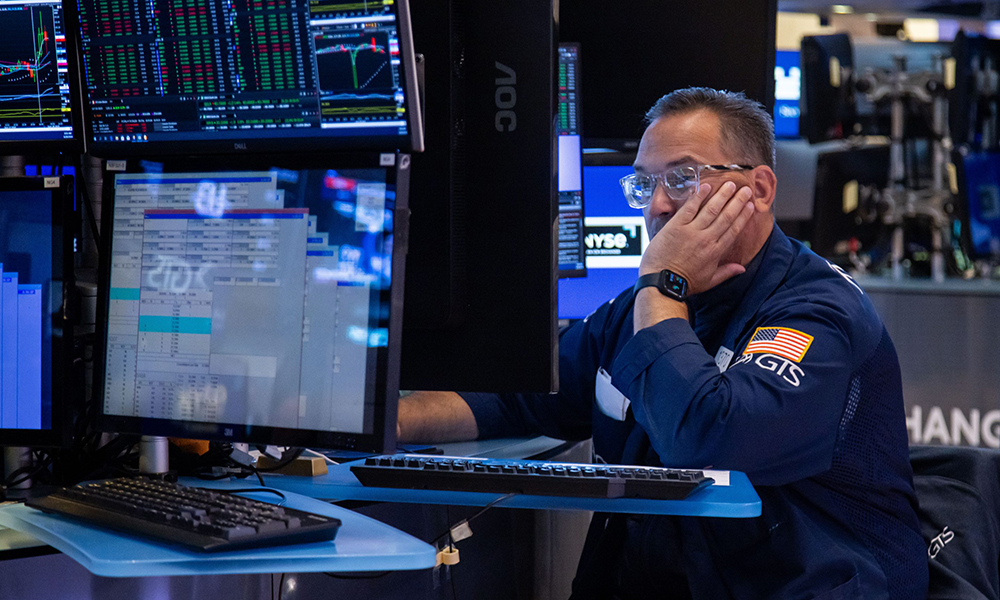
如今,围绕人工智能的炒作已避无可避。高管们利用一切机会向感兴趣的投资者以及兴趣稍低的消费者强调其人工智能能力,因此,关于个人机器人助手和神奇的癌症治疗等新发展的承诺无处不在。
然而,并非所有人都受到人工智能大肆宣传的震撼。总部位于英国的宏观经济研究公司MacroStrategy Partnership的创始合伙人詹姆斯·弗格森(James Ferguson)担心,投资者对人工智能的狂热会造成市场泡沫集中,这让人想起互联网泡沫时代。
弗格森在最新一期Merryn Talks Money播客中对彭博社记者梅里恩·萨默塞特·韦伯(Merryn Somerset Webb)说:“从历史上看,这些泡沫都会带来糟糕结局。因此,任何上了年纪并遇到过这种情况的人,都会倾向于相信结局会很糟糕。”
这位资深分析师认为,幻觉——大型语言模型(LLM)倾向于编造事实、来源等——可能比最初预期的更棘手,导致人工智能的可行应用大大减少。
他表示:“我认为,人工智能仍然未经完全证实。在硅谷,‘伪装一切,直到成功’可能行得通,但对于我们其他人来说,我认为‘一朝被蛇咬,十年怕井绳’可能更适用于人工智能。如果人工智能不可信……那么在我看来,人工智能实际上一无是处。”
弗格森还指出,人工智能最终可能会因过于“耗电”而无法成为许多企业的高性价比工具。Amsterdam School of Business and Economics最近的一项研究发现,到2027年,仅人工智能应用的用电量就相当于整个荷兰的用电量。
他表示:“先不谈英伟达(Nvidia)对其芯片收取越来越高的费用,你还必须为在服务器上运行这些芯片支付越来越多的费用。因此,你最终得到的是非常昂贵的东西,而且除了一些适用面狭窄的应用之外,无法在任何地方证明它是物有所值的。”
对于投资者,尤其是那些对人工智能充满热情的投资者,弗格森警告说,基于可疑承诺的过度科技炒作与互联网泡沫破裂前的时期非常相似。他指出,在这两个时期,市场回报都集中在科技股上,而科技股的交易基于华尔街的超高盈利增长预期。
但是,尽管有这些高预期,互联网时代的硬件巨头思科(Cisco)和英特尔(Intel)从那时起就一直让投资者失望。弗格森认为,今天的人工智能硬件巨头英伟达可能也会经历类似的命运,尤其是考虑到其过高的估值。
他问道:“如果你认为英伟达在十年后可能都不再是芯片领域的玩家(不管目前的增长率有多高),那么英伟达的销售额乘数是多少才划算呢?”这暗示英伟达可能不值投资者目前支付的近40倍销售额的价格。
尽管弗格森认为,像英伟达这样与人工智能相关的科技股估值过高,但他也承认,没有人能预测泡沫何时会结束。根据这位分析师的说法,这种动态导致许多看跌的投资者即使在股票看起来很贵的时候也觉得“被迫”参与市场投资,这是一种很容易受损的方式。
他解释说:“我的意思是,这肯定是互联网泡沫时期发生的情况,例如,几乎所有不是散户的人都会看着这些情况说,‘好吧,这不可能持续下去,但话虽如此,如果这种情况再持续一个季度,而我不参与的话,我就会失业。’”
弗格森认为,好消息是,由于目前股市的泡沫主要集中在与人工智能相关的股票上,因此仍然是有价值的。
诚然,如果人工智能泡沫破裂,投资者将普遍感到痛苦。但在那之后,弗格森建议关注目前不受青睐的美国小盘股,这些股可能会从降息中受益,而且估值并不高。
他说:“在美国有很多价值可寻。问题是,这些价值要通过传统的方式来寻找,即在小盘股中搜罗,寻找那些以传统方式实现稳步增长的企业。”(财富中文网)
译者:中慧言-王芳
如今,围绕人工智能的炒作已避无可避。高管们利用一切机会向感兴趣的投资者以及兴趣稍低的消费者强调其人工智能能力,因此,关于个人机器人助手和神奇的癌症治疗等新发展的承诺无处不在。
然而,并非所有人都受到人工智能大肆宣传的震撼。总部位于英国的宏观经济研究公司MacroStrategy Partnership的创始合伙人詹姆斯·弗格森(James Ferguson)担心,投资者对人工智能的狂热会造成市场泡沫集中,这让人想起互联网泡沫时代。
弗格森在最新一期Merryn Talks Money播客中对彭博社记者梅里恩·萨默塞特·韦伯(Merryn Somerset Webb)说:“从历史上看,这些泡沫都会带来糟糕结局。因此,任何上了年纪并遇到过这种情况的人,都会倾向于相信结局会很糟糕。”
这位资深分析师认为,幻觉——大型语言模型(LLM)倾向于编造事实、来源等——可能比最初预期的更棘手,导致人工智能的可行应用大大减少。
他表示:“我认为,人工智能仍然未经完全证实。在硅谷,‘伪装一切,直到成功’可能行得通,但对于我们其他人来说,我认为‘一朝被蛇咬,十年怕井绳’可能更适用于人工智能。如果人工智能不可信……那么在我看来,人工智能实际上一无是处。”
弗格森还指出,人工智能最终可能会因过于“耗电”而无法成为许多企业的高性价比工具。Amsterdam School of Business and Economics最近的一项研究发现,到2027年,仅人工智能应用的用电量就相当于整个荷兰的用电量。
他表示:“先不谈英伟达(Nvidia)对其芯片收取越来越高的费用,你还必须为在服务器上运行这些芯片支付越来越多的费用。因此,你最终得到的是非常昂贵的东西,而且除了一些适用面狭窄的应用之外,无法在任何地方证明它是物有所值的。”
对于投资者,尤其是那些对人工智能充满热情的投资者,弗格森警告说,基于可疑承诺的过度科技炒作与互联网泡沫破裂前的时期非常相似。他指出,在这两个时期,市场回报都集中在科技股上,而科技股的交易基于华尔街的超高盈利增长预期。
但是,尽管有这些高预期,互联网时代的硬件巨头思科(Cisco)和英特尔(Intel)从那时起就一直让投资者失望。弗格森认为,今天的人工智能硬件巨头英伟达可能也会经历类似的命运,尤其是考虑到其过高的估值。
他问道:“如果你认为英伟达在十年后可能都不再是芯片领域的玩家(不管目前的增长率有多高),那么英伟达的销售额乘数是多少才划算呢?”这暗示英伟达可能不值投资者目前支付的近40倍销售额的价格。
尽管弗格森认为,像英伟达这样与人工智能相关的科技股估值过高,但他也承认,没有人能预测泡沫何时会结束。根据这位分析师的说法,这种动态导致许多看跌的投资者即使在股票看起来很贵的时候也觉得“被迫”参与市场投资,这是一种很容易受损的方式。
他解释说:“我的意思是,这肯定是互联网泡沫时期发生的情况,例如,几乎所有不是散户的人都会看着这些情况说,‘好吧,这不可能持续下去,但话虽如此,如果这种情况再持续一个季度,而我不参与的话,我就会失业。’”
弗格森认为,好消息是,由于目前股市的泡沫主要集中在与人工智能相关的股票上,因此仍然是有价值的。
诚然,如果人工智能泡沫破裂,投资者将普遍感到痛苦。但在那之后,弗格森建议关注目前不受青睐的美国小盘股,这些股可能会从降息中受益,而且估值并不高。
他说:“在美国有很多价值可寻。问题是,这些价值要通过传统的方式来寻找,即在小盘股中搜罗,寻找那些以传统方式实现稳步增长的企业。”(财富中文网)
译者:中慧言-王芳
There’s no avoiding the hype surrounding AI these days. Promises of new developments like personal robot assistants and miracle cancer cures are ubiquitous as executives take every opportunity to emphasize their AI chops to enthusiastic investors—and slightly less enthusiastic consumers.
Not everyone has been blown away by the AI fanfare, however. James Ferguson, founding partner of the UK-based macroeconomic research firm MacroStrategy Partnership, fears investors’ AI exuberance has created a concentrated market bubble that’s reminiscent of the dot-com era.
“These historically end badly,” Ferguson told Bloomberg’s Merryn Somerset Webb in the latest episode of the Merryn Talks Money podcast. “So anyone who’s sort of a bit long in the tooth and has seen this sort of thing before is tempted to believe it’ll end badly.”
The veteran analyst argued that hallucinations—large language models’ (LLMs) tendency to invent facts, sources, and more—may prove a more intractable problem than initially anticipated, leading AI to have far fewer viable applications.
“AI still remains, I would argue, completely unproven. And fake it till you make it may work in Silicon Valley, but for the rest of us, I think once bitten twice shy may be more appropriate for AI,” he said. “If AI cannot be trusted…then AI is effectively, in my mind, useless.”
Ferguson also noted AI may end up being too “energy hungry” to be a cost effective tool for many businesses. To his point, a recent study from the Amsterdam School of Business and Economics found that AI applications alone could use as much power as the Netherlands by 2027.
“Forget Nvidia charging more and more and more for its chips, you also have to pay more and more and more to run those chips on your servers. And therefore you end up with something that is very expensive and has yet to prove anywhere really, outside of some narrow applications, that it’s paying for this,” he said.
For investors, particularly those leaning into the AI enthusiasm, Ferguson warned that the excessive tech hype based on questionable promises is very similar to the period before the dot-com crash. He noted that during both of these periods, market returns were concentrated in tech stocks that traded based on Wall Street’s sky-high earnings growth estimates.
But despite those lofty forecasts, the dominant hardware giants of the dot-com era, Cisco and Intel, have largely disappointed investors ever since. Ferguson argued today’s AI hardware hero, Nvidia, might experience a similar fate, particularly given its elevated valuation.
“What multiple of sales is Nvidia a good deal on if you think that it might only have—no matter how stratospheric the growth rate at the moment—if you think that it’s probably not going to be a player in a decade’s time?” he asked, implying Nvidia might not be worth the current price tag of nearly 40 times sales investors are paying.
Despite his argument that AI-linked tech stocks like Nvidia are highly overvalued, Ferguson admitted that no one can predict when a bubble will end. This dynamic leads many bearish investors to feel “compelled to play” in the markets even when stocks look pricey, according to the analyst—and that’s a great way to get hurt.
“I mean, it’s certainly what was happening in the dotcom [bubble], for example, where almost anybody who wasn’t a retail punter was looking at these things and saying, ‘well, it can’t last, but having said that, if it lasts one more quarter and I’m not playing, I’ll lose my job,’” he explained.
The good news, according to Ferguson, is that because the current stock market bubble is so concentrated in AI-linked stocks, there is still value out there.
Of course, there will be widespread pain for investors if the AI bubble bursts. But after that, Ferguson recommended looking at the currently unloved U.S. small-cap stocks, which may benefit from interest rate cuts and aren’t highly valued.
“There’s a lot of value to be found in the U.S. The trouble is that that value is to be found in good old fashioned ways, trawling through small caps and looking for businesses that are growing in a good old fashioned, steady way,” he said.






